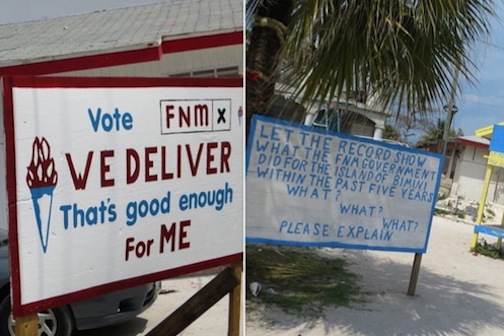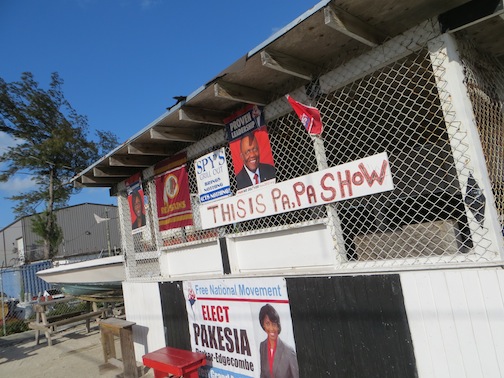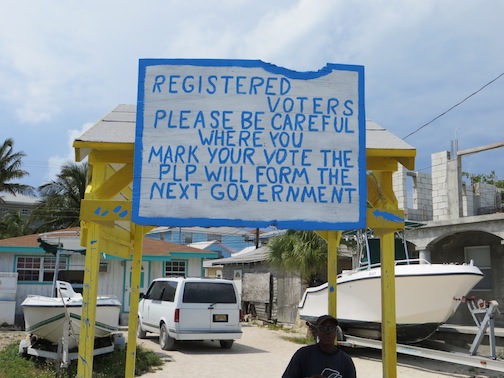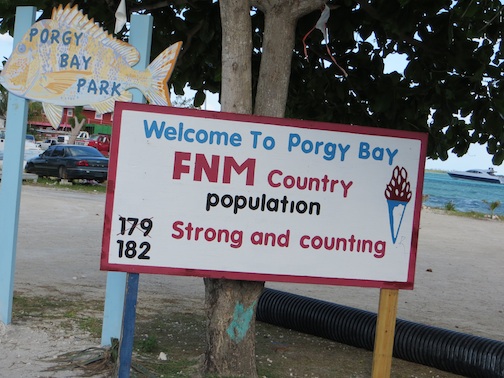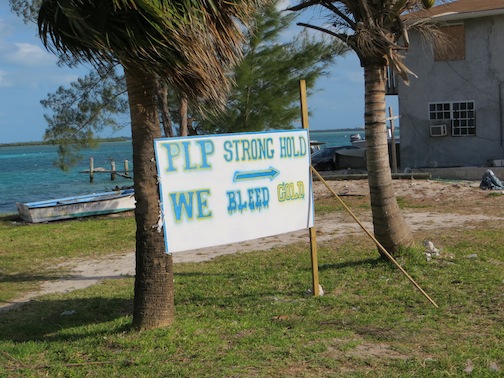Above: two of the many political signs adorning Bimini’s main thoroughfare (CJ Photo)
By Alexander Britell
BIMINI — Large billboards dominate the landscape along King’s Highway, some artful, others strongly-worded.
It’s election season in the westernmost district of the Bahamas, and for a few weeks, it’s red and gold, not the typical turquoise, that define Bimini.
Bahamian Prime Minister Hubert Ingraham has called elections for May 7, and Bimini, which is part of the West End (of Grand Bahama) and Bimini constituency, is heating up.
While a third party, the Democratic National Alliance, launched in the country in 2011, it’s the ruling Free National Movement’s red and the Progressive Liberal Party’s blue and gold that cover the island.
The FNM and Ingraham lead the government, but Bimini’s seat is held by the PLP’s Obie Wilchcombe, who is facing off against the FNM’s Pakesia Parker-Edgecombe, a former journalist.
Bimini will play a role in choosing the country’s next government, which will be led by either current Prime Minister Hubert Ingraham, the PLP’s Perry Christie (who served as PM from 2002 to 2007) or the DNA’s Branville McCartney (a former FNM MP).
“We as Biminites just want what is best for Bimini,” said Latoya Dean, a PLP supporter. “Right now, we don’t have anything for the children to do — as a mother of three, this for my children. Perry cares when it comes to the Bahamas, he’s not just a one-man party. Hubert is just a one-man party.”
The two parties’ campaign headquarters are separated by just a few blocks, with the distance between them a sea of red and gold.
“The FNM, and I’m serious and honest about this, is the best choice because of the history,” said Lloyd Edgecombe, the FNM’s campaign coordinator for the Bimini district. “If you look around Bimini, most of the things that happened in the community, the new clinics, the development of the electrical company and new developments in the private sector, have been done under the FNM government.”
Supporters of both parties say education, and the island’s youth, are Bimini’s biggest issues.
“For the longest time, we wanted a high school and never got it,” PLP supporter Marsha Levarity told Caribbean Journal. “The PLP had it planned, but when the present government came in, they canceled it. So that’s one of our biggest issues, a school for Bimini.”
On any trip down King’s Highway, it’s hard not to notice the large-scale signs put up by supporters of each party — some particular to Bimini, others promoting the national race, with a passion that belies Bimini’s small size.
The FNM’s signs are characterized more by photos and slogans, the PLP’s by long textual addresses.
“The reason why we are so passionate is because of asking for what you want and being denied — that makes us very passionate,” Dean said. “When you have nothing for the children to do, and you’re a single, struggling mother, we should get passionate, and we should fight for what we want, what we deserve.”
That passion, Edgecombe says, comes from a history of jockeying between the two parties.
“In the past, the PLP has had a history of victimization and some of us, around my age in their 50s, we can remember the old days, with the PLP generals,” he said. “You had to be PLP in order for things to happen for you, whether it was car licences or even jobs; if you weren’t PLP, you couldn’t get anything done in the community. We changed that culture from 1992, and that’s why we are so passionate — because we’ve been fighting for our share of the economic pie. It’s difficult, but we’ve been making inroads.”
For FNM supporter John “Roller” Rolle, it’s simpler.
“The FNM is stronger, they’re more reliable,” he said. “That’s why they’re my choice.”
